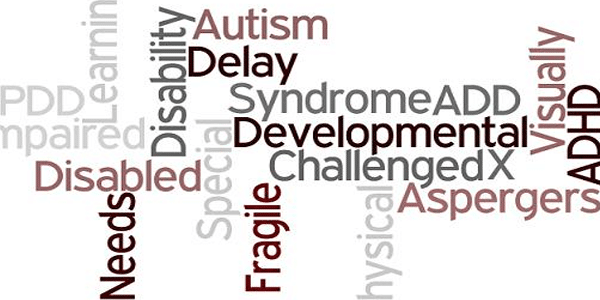According to the Centers for Disease Control, 1 in 7 children in the United States are diagnosed with a developmental disability, a category encompassing conditions such as Autism Spectrum Disorder and Down Syndrome. Once primarily an issue for parents and doctors, this is becoming a more prevalent issue for employers as the challenges facing employees parenting special-needs children seep into the workplace.
As developmental disabilities increase in prevalence, more parents must navigate the challenges of finding accurate and useful information, devising effective ways to manage their children’s conditions, and accessing appropriate treatment. As they do this, they face sparse and conflicting reports, a severe lack of resources and specialists, and high stress levels.
The difficult and time-consuming aspects of caring for special-needs children can make it hard for good employees to work at full capacity, and for companies to get the most benefit from their skills. Many employers find themselves at a loss for practical means of addressing these obstacles.
Though there is no one-size-fits-all formula, there are creative and cost-effective ways that employers can address these challenges. Mike Civello, Vice President of Employee Benefits at Rethink, visited TemPositions’ Roundtable series on Thursday, April 30, 2015, to share information and statistics about autism and developmental disabilities, the challenges they present for companies and their employees, and what can be done to address these challenges.
Areas of change
Civello outlined three major areas of benefits that are undergoing major changes.
- Developmental disabilities: This category includes Autism Spectrum Disorder, as well as issues such as Down Syndrome and ADHD. Civello noted that autism is now classified as a medical issue, whereas it was previously classified as a mental and behavioral issue. Applied Behavioral Analysis (ABA) is the preferred treatment approach.“There’s some liability there in terms of getting it covered for employees,” said Civello.
- Transgender reassignment surgery: Previously classified as a mental disorder, transgender is now categorized as a medical condition. Civello noted that some major self-insured companies such as Amazon are adding coverage for reassignment surgery.“You can now get your reassignment surgery covered by your medical plan, and a lot of companies are going in that direction,” said Civello.While self-insured plans are exempt from covering reassignment surgery, Civello said that once something is classified as a medical condition, there is “quite a bit of pressure” to add coverage.
- Infertility: This is also now classified as a medical issue.
“There’s a huge focus on employee well-being these days in general, and I think every company is taking their own approach on it, and I think there is a real lack of standardization,” said Civello.
The main focus of the Roundtable was developmental disabilities, particularly Autism Spectrum Disorder. April is National Autism Awareness Month, and April 2 is World Autism Awareness Day.
“Awareness has come a long way,” enthused Civello.
He asked attendees if they were familiar or personally affected by developmental disabilities, and some attendees indicated that they were.
Buzzwords to know
ASD: Autism Spectrum Disorder. This includes Asperger’s syndrome, which is a form of autism. People with various forms of autism are sometimes described as being “on the spectrum.”
ABA: Applied Behavioral Analysis. This is the most highly recommended treatment approach for ASD. It is endorsed by the Surgeon General and National Institutes of Health.
BCBA: Board-Certified Behavioral Analyst. This is considered the gold standard for providers servicing those affected by autism. They must complete over 1500 hours of supervision to earn this certification. There is a massive shortage of BCBAs.
Scope and prevalence
According to the CDC, 1 in 7 children are diagnosed with a developmental disability.
“If you don’t think it affects your workforce, it does,” said Civello. “That’s 14 percent of the population.”
He said that many of the treatment principles, services, and things employers can do for parents of families with autistic children are also applicable to other developmental disabilities.
The CDC reports that 1 in 68 children are diagnosed with ASD nationally. New Jersey has the highest prevalence at 1 in 47. Civello notes that this may be somewhat skewed because New Jersey has some of the best ASD services, and people may move there to access these services. Technically, the state with the highest diagnosis rate is Utah, with 1 in 54.
ASD is a global issue. The UK reports a 1 in 50 diagnosis rate, and China 1 in 44.
The ASD diagnosis rate has increased twentyfold in the last 20 years. There is no known cause for the increase, or for the condition itself. Civello thinks the increase in diagnosis rates is likely a combination of increased prevalence, better diagnosis and understanding of developmental disabilities, and more awareness.
Most statistics Civello shared at the Roundtable were drawn from the CDC, from reports from the National Business Group on Health, and from reports from Rethink.
Access to treatment
A shortage of Board-Certified Behavioral Analysts (BCBAs) has resulted in difficulty accessing treatment for many families affected by ASD. There are about 6,000 BCBAs worldwide. In the U.S., there are approximately 2,800 BCBAs to serve a million people affected by ASD. Places with bigger populations like California, Texas, and the New York metro area have more providers. Some states have fewer than 10 providers. Even in areas with more providers, a 6-12 month wait for an appointment is not uncommon.
“There are a lot of stories we’ve heard of employees at companies trying to get a provider and traveling 200 miles to be seen,” recounted Civello. He added that others move to be closer to treatment providers.
Civello mentioned that the problem is even worse outside the U.S.: the whole of Saudi Arabia has only one provider.
Effects on employers
Cost
Self-insured plans are exempt from providing ABA treatment services, but the biggest issue for many employers attempting to address ASD is the cost. Civello said that ABA treatment averages $60,000-$75,000/year per child. Given that the diagnosis rate has increased twentyfold in the last 20 years, more and more employers find themselves struggling to cope with the associated costs.
The average cost added to a health plan that includes a developmental disabled child is $6,200. The cost of clinic visits and hospitalization is approximately double that of a traditional plan. Behavioral issues that stem from ASD, such as self-injuring behavior, drive up the cost. Also, routine care like dental appointments often requires additional measures such as sedation to get developmentally disabled children treated without incident. The average prescription drug cost is seven times higher than for plans that do not include a developmentally disabled child.
Loss of productivity and employees
Lost productivity is another issue and cost employers face. Civello said that on average, 250 hours per employee per year are lost in productivity as a result of what it is involved in caring for a child with a developmental disability. 24 hours of hands-on care per week is the average number of hours that a child with developmental disabilities is prescribed to have.
“Picture a parent trying to make 24 hours a week work with school and other activities. It becomes almost physically impossible,” said Civello. “In a two-parent household, often one parent is leaving the workforce, or cutting down on hours by maybe 50 percent, or going down to part-time.”
Civello discussed a recent Washington State University study about the impact of caring for a child with a developmental disability on full-time working mothers. 53 percent had cut their hours, and 58 percent had passed on a job altogether, and nearly a quarter passed on a promotion.
Employee experiences and challenges
“A lot of people don’t personally know what it’s like to have a child with a developmental disability in the home,” said Civello.
A lack of firsthand knowledge means that employers are often unaware of the issues that result, or what sort of changes will have meaningful impact.
Because the challenges of caring for children with developmental disabilities are usually unfamiliar to those who have not personally experienced them, many parents don’t feel comfortable asking for help from their employers.
“There’s unfortunately still a lot of stigma attached,” said Civello. “They’re concerned that identifying themselves – specifically with regard to the statistics about cutting hours – they are then going to be seen as not promotable. Or, they’re going to be seen as having constant conflict, and being unreliable.”
A window into life with ASD
Civello showed several clips from the NBC sitcom “Parenthood” to illustrate the “basic human side” and process parents go through in getting a diagnosis, and dealing with the aftermath. He mentioned that the show has garnered praise from autism awareness organizations for its authenticity and sympathetic, realistic portrayal of ASD.
The first clip showed a child initiating a physical altercation with another student that had teased him during class. The teacher has difficulty calming and restraining the child who lashed out after he bit the other boy who had teased him.
The second clip showed a discussion between a doctor and parents, in which the doctor diagnosed their son with Asperger’s. The doctor explains to the shocked and perturbed parents that it is a lifelong condition, and that parental involvement is the most crucial factor in helping their son achieve as much as possible.
The third clip showed a support group meeting for parents of children with Asperger’s. Mothers broke down when relating the difficulties of caring for their children with Asperger’s.
“This is what your employees in a greater or lesser sense are going through daily,” Civello told attendees.
Both before and after a diagnosis, many parents turn to the internet to find information. They are met with a deluge of overwhelming, conflicting, and sometimes outright inaccurate information. Civello mentioned the discredited study that associated autism with vaccines as an example of the types of things parents must navigate when looking for information to help their children, and the widespread effects wrought by incorrect information. When trying to find helpful information, parents are often scared and uncertain, as they don’t know what cased their children’s issues, or what will help.
Civello said that fewer than half of ASD cases are diagnosed before a child is four years old, but warning signs can present as early as nine months. The path from noticing that something is “off” to getting a diagnosis is often a rocky one.
“There can be years that are going by where parents are like, ‘there is something wrong,’ and yet no diagnosis comes,” said Civello. “I think parents are doing a lot on their own. They haven’t been directed to healthcare yet.”
Parents can be further discouraged when they find out that the best outcomes result when ABA treatment has been started early – even before an official diagnosis.
Most diagnoses are made after a pediatrician refers parents to a developmental pediatrician. After receiving the diagnosis, they are often sent away without a treatment plan or any training.
“A lot of ABA treatment plans are supposed to include parent training and coaching – how to effectively work with your child,” explained Civello. “Unfortunately because of the lack of providers and and the shortage of resources, there’s typically little to no time for that.”
What employers can do
“It’s critical to really understand what’s going on for these people, and not just think linear, i.e. medical coverage or not, or is medical coverage enough?” said Civello.
He encouraged a holistic approach, saying that the ultimate goal is to keep employees in the workforce. He noted that many conversations with employers center around waiting for medical coverage to step in, or waiting for carriers to take care of it, but encouraged attendees to expand beyond that, and create environments in which employees feel comfortable bringing up issues with their employers to find workable solutions.
Civello also reminded attendees that conditions like ASD are lifelong, and parents often support their developmentally disabled children into adulthood. Despite this, these children are often no longer eligible for coverage under their parents’ health insurance, and do not show up as dependents on paper.
Challenges and solutions
Civello encouraged HR departments to be innovative in creating solutions – “inventing a way when there seemingly is no way.”
“A lot of employers are pretty stuck,” he explained. “They don’t know how to size the population, there’s no claims data to support because there hasn’t been an existing benefit, there’s no ICD-9 codes to pull for the most part, and then when they do start to address it, the cost seems insurmountable.”
Civello defined “benefits” in a broader context, using the dictionary definition as “something that is advantageous or good.” He urged attendees to keep this definition in mind with regard to employee benefits, and to remember the human side of their work.
He stressed that the most important thing was to take care of basic employee needs.
“If you’re not even serving their most basic needs, you cannot expect them to be engaged in your workforce, or even come to work,” he said.
He advised attendees to leverage Autism Awareness Month in April to introduce and bring attention to the issue in their workplaces. Mother’s Day in May and Father’s Day in June could also be used for this purpose.
Civello cautioned that when trying to assess what needs to be done, claims usually don’t reveal the full picture. He recommended that attendees instead look at the full population, then look at the number of dependents and at tax forms. From there, he advised them to calculate 14 percent of that number to get a basic idea of how many employees are affected by developmental disabilities. He based this on the CDC statistic of 14 percent of children being diagnosed with a developmental disability.
Innovative options
Civello urged any employers who are able to add applied behavioral analysis (ABA) to their coverage, but acknowledged that this may not be possible for many companies due to the expense. For employers who cannot sponsor this benefit, he advised coming up with a task force on the issue to make employees feel heard.
One possibility he highlighted was providing resources to help parents plan in light of the obstacles they face. This could take the form of financial planning services, support for developmentally disabled dependents transitioning into adulthood, and assistance getting into the job market and living independently.
Civello also encouraged attendees to embrace technology, particularly telemedicine and tele-consulting. He mentioned that most BCBAs are women, and eventually leave the workforce due to both high burnout rates, and because they have their own children at home. However, many practice telemedicine as a means of continuing to work in the field while balancing their own needs. This is also helpful for families who are not located near providers, as it saves them travel time.
“They’re doing video calls with parents, coaching and training them in the home to work with their child, they can see them in the home,” he said. “Get comfortable with technology, because your employees are.”
Civello predicted that technology and telemedicine would come into play with more and more conditions. Microsoft is working on motion-detecting software that allows therapists to remotely attend to patients with physical disabilities and injuries.
A business case for benefits
In addition to new technologies, there are also traditional resources that can help. For companies eager to boil everything down to ROI, Civello posed the question: “what’s the cost of doing nothing?” He encouraged attendees to used the available statistics and research to show the numbers of employees who leave the workforce, pass up promotions, and cut hours.
“All of those things are your business case,” he said.
He also advised utilizing sales and marketing teams to help craft a compelling business case for addressing these issues. Focusing on the cost of doing nothing, featuring anecdotes, and even using video excerpts are some strategic approaches to get executives to pay attention to the need to address developmental disabilities. Given the national and multinational nature of many companies, executives may be out of touch with the everyday challenges facing employees dealing with developmental disabilities. For example, executives in California, where there are more BCBAs, may not be aware of the hardships in accessing similar care for their employees in Iowa.
“The purpose of all of this is to create new advantages,” Civello concluded. “I really believe that in employee benefits and HR, this is what are jobs are every day: to create new advantages for our companies for creating new advantages for our employees.”
Discussion
In discussion at the end of Civello’s presentation, an attendee mentioned that in her experience, HR often doesn’t find out that employees are having difficulties balancing care for special-needs children until after these employees quit. She asked how employers could be more proactive in identifying and addressing these issues.
Civello advised against asking employees to identify themselves due to sensitivity and stigma. He suggested advertising and offering support that employees can use passively. This can take the form of posters, handouts, web portals, and more.
“If they see a service advertised at work, they can take it home and use it at home,” he said.
Resources
Civello shared a list of resources that may be helpful for attendees.
- Autism Speaks (https://www.autismspeaks.org/) This organization funds medical research, increases awareness, and advocates for the needs of people with ASD and their families.
- My Autism Team (http://www.myautismteam.com/) This organization offers peer-to-peer support for families dealing with ASD. It helps parents connect with one another, which is a critical form of support.
- National Business Group on Health (https://www.businessgrouphealth.org/) This group had done many in-depth reports on the costs and impacts on employers and employees in relation to developmental disabilities and related topics.
- Rethink Autism (https://www.rethinkfirst.com/) This is Civello’s company, and works to connect parents, educators, and medical professionals working with special-needs children to evidence-based treatment solutions. Clients include Amazon and Starbucks. He encouraged attendees to reach out to him personally, and to reach him on Twitter at @MikeCivello.
- Washington State University (http://depts.washington.edu/uwautism/index.php) This university (specifically its Vancouver, WA campus) has produced trailblazing research on the impacts of caring for children with autism on working mothers.
- Centers for Disease Control and Prevention (http://www.cdc.gov/) This government agency provides the most up-to-date statistics and information on diagnosis rates for children with developmental disabilities.
- American Psychiatric Association (http://www.psychiatry.org/)
- American Academy of Pediatrics (https://www.aap.org/en-us/Pages/Default.aspx)These two organizations give different perspectives about what is going on in the industries around developmental disabilities.
- National Public Radio (http://www.npr.org/tags/136582388/autism) NPR has an abundance of postings and news about adults with autism and developmental disabilities.
- Steven Silberman (http://stevesilberman.com/) Silberman is an author and expert on neurodiversity. He wrote the forthcoming book “NeuroTribes: The Legacy of Autism and the Future of Neurodiversity,” and is at the forefront of the neurodiversity movement, which focuses on creating better work environments for adults with autism and other disabilities.
- Dame Stephanie “Steve” Shirley (http://www.steveshirley.com/home) After escaping Austria during World War II, Shirley built a billion-dollar business despite having a severely autistic child. She is leader in autism advocacy, and author of “Let It Go: The Story of the Entrepreneur Turned Ardent Philanthropist,” a memoir of her life experiences.
- Resource for Children with Special Needs (http://www.resourcesnyc.org/) This New-York-based organization mentioned by a Roundtable attendee has many resources and links to help parents of special-needs children navigate the transition out of high school and into adulthood for their children, which can be especially stressful and difficult for parents.Andrea Burzynski is a freelance writer based in New York. Reach her at andrea.burzynski@yahoo.com.The HR Roundtable is a breakfast forum for human resources professionals in New York City sponsored by The TemPositions Group of Companies. TemPositions, one of the largest staffing companies in the New York tri-state area with operations in California, has been helping businesses with their short- and long-term staffing needs since 1962. Visit them online at www.tempositions.com or email them at info@tempositions.com.
Join the next HR Roundtable
Don’t miss our next discussion! Sign up for TemPositions’ next HR Roundtable here. This SHRM certified event will earn you or your HR team members 1.5 professional development credits.
Please note: the information reflected in this post is not official legal advice nor does it necessary reflect the opinions of the associated firms.






